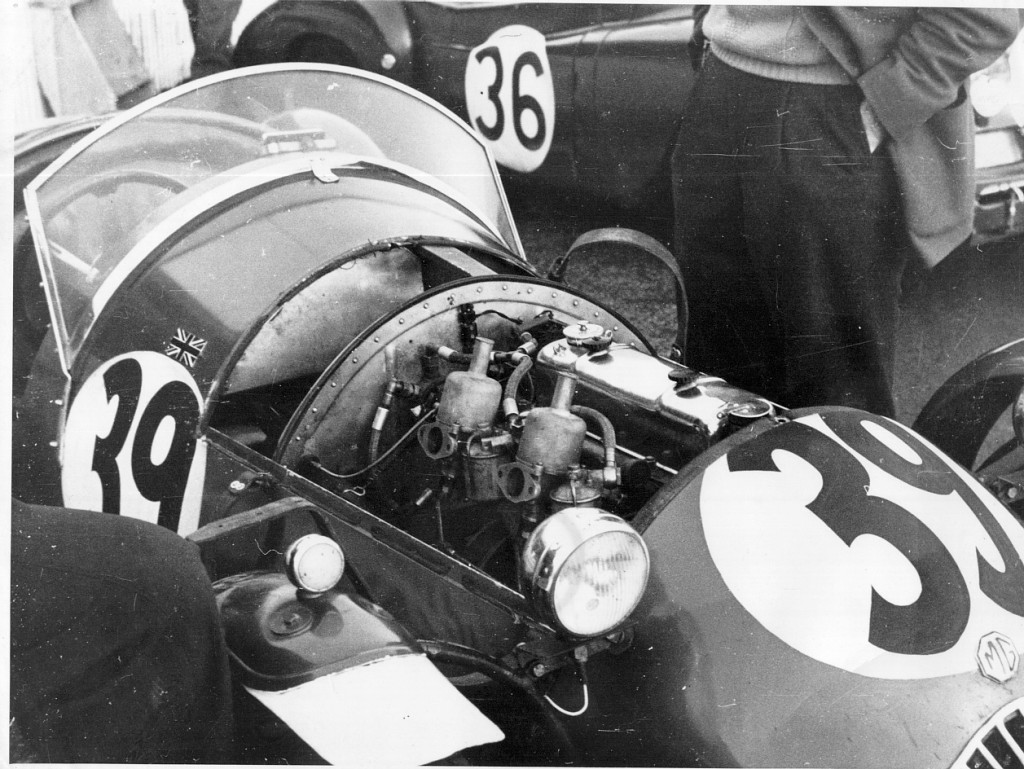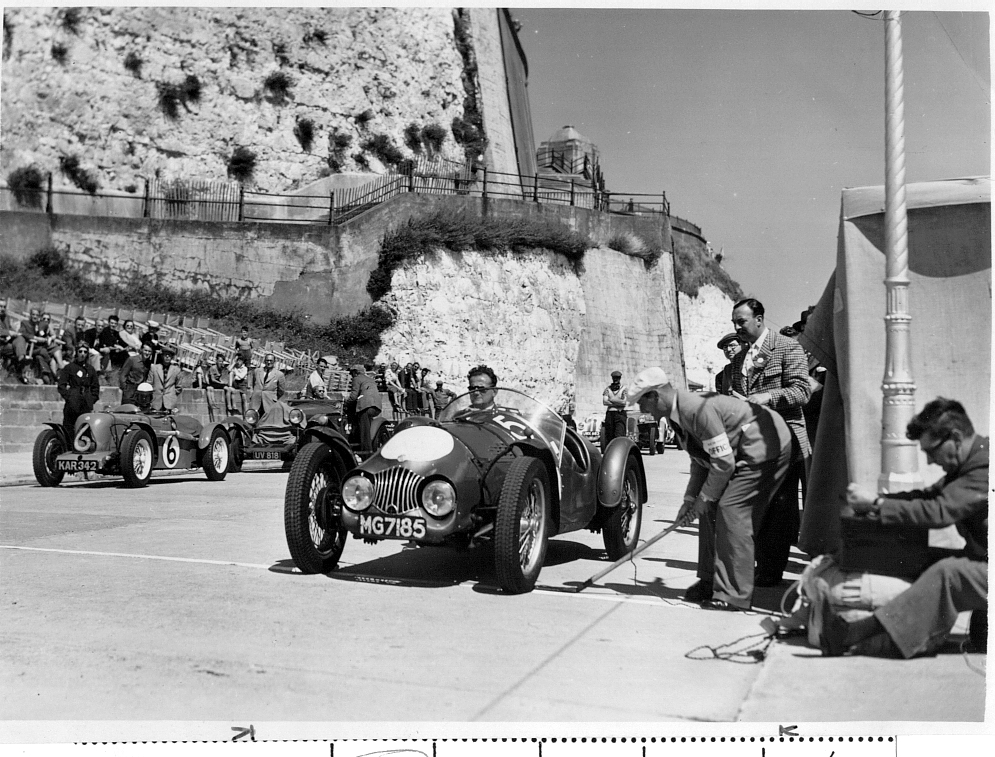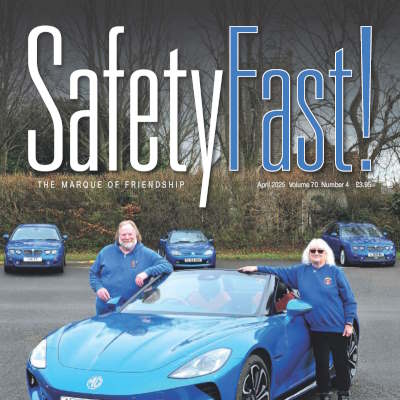A life with MGs (and cameras)
Reproduction in whole or in part of any article published on this website is prohibited without written permission of The MG Car Club.
This article started life as a talk by George Phillips to an audience of American T owners, of the New England M.G. T-Register, a few years before his death. It was part of a special three-part series that features in Safety Fast! from May, June and July 2000.
George, in case you didn’t know, was chief photographer for Autosport magazine in the 1950s and ’60s, when that magazine was much more tuned to grass-roots motor sport, and the more interesting for that.
He was also no mean driver in T-Types, venturing to Le Mans and elsewhere with a special-bodied TC in the late 1940s and early ’50s, including the works teams of TCs and TDs, and a ‘ID clothed in a prototype MGA body.
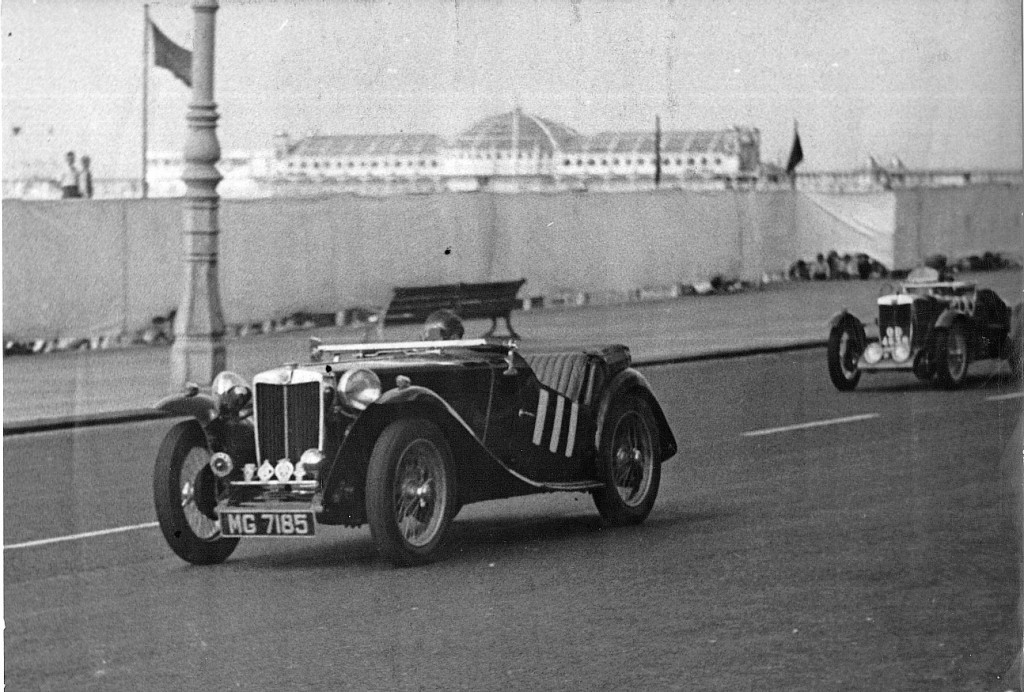 The start of it all, Brighton Speed Trials. Leaving the start with Geoff Cole’s blown J4.
The start of it all, Brighton Speed Trials. Leaving the start with Geoff Cole’s blown J4.
My association with M.G.s started at University Motors in Piccadilly, London, when I handed over a cheque for just under £500, and in exchange took delivery of MG 7185, a black TC with red leather upholstery.
I was bitterly disappointed as I drove the car because the steering was absolutely terrible. It was so stiff that there was no castor action whatever in it, and if you steered from either right or left you had to drag it back to the central position. I complained bitterly about this to the salesman and he said, “oh dear, you have one of those have you?
We’ve had a lot of complaints about the steering boxes. They have had a bad batch from the steering gear people, but we’ll put you one on order and as soon as it comes to hand well give you a ring and we’ll change it for you.” (This may explain why some current TC owners complain about steering, and others – like me – don’t!! APW).
So I took the car away. It was a bit of a pig to drive under those conditions, however, only two or three days elapsed when they ‘phoned me up to say they had got a new steering box. I took it down there and they replaced the steering box. Would you believe the new one was as bad as the old one? Eventually, however, this trouble was put right, and I now had a perfectly nice mobile TC which, at this point, I didn’t really want as I had, at the time, a 2 litre Aston Martin.
This was a delightful two-seater sports car with a chromed outside exhaust and was a really pretty motor. It handled well but unfortunately the engine left a lot to be desired.
I took it back to the dealer on one occasion complaining bitterly that it would only do 87 miles an hour. Whereupon, they replied that I had no right to be doing that speed as it was geared to do only 85. If I was doing 87, I was over revving it! I put up with this thing for quite some time. It was a very nice car but I could just not afford the luxury of going fast, because if I did, something would break.
Then, the final act was taking it back to the dealer. Before I got there, it spread its engine all over the North Circular Road in a monumental blow-up, with bits and pieces of engine all over the road that were eventually swept up and put in a sack. I towed the lot back to where I bought the car from and that was the finish of the Aston Martin.
I wasn’t, however, a great deal better off, because the TC, although being brand new, still wasn’t very quick. I think 74 miles per hour was absolutely top-whack and I must admit I was rather disappointed, so I set about trying to sell it.
Well, in those days in England there was a thing called a covenant, which forbade the sale of new cars before the period of two years elapsed. Naturally enough this made disposing of the TC rather difficult; in the end I said the hell with it, I’ll keep it, but somewhere or other I had to get a bit more performance from it.
At this point I must stress that I knew absolutely nothing about engines or the like, but I took it down, inspected it, and it was elementary that some things were wrong with it.
First and foremost, the ports didn’t line up with the manifold. I bought myself a flexible grinder and put that point right, and since it seemed to go a bit better, I’d enter it in Brighton Speed Trials, which is a kilometre blind along the front of Brighton. I went down to the M.G. works at Abingdon to ask them if there was anything I could do to “hot” the thing up, and I was told by a Mr. Haddock (who was affectionately known as “fish”) that there was nothing that I could do with the engine as it was fully developed.
It was giving 54 horsepower and if I messed about with it, my warranty wouldn’t be honoured. However, he did suggest that I put a blanking plate across the bottom of the radiator that would make it run a bit hotter, and that probably I could put richer needles in that might increase the performance a bit.
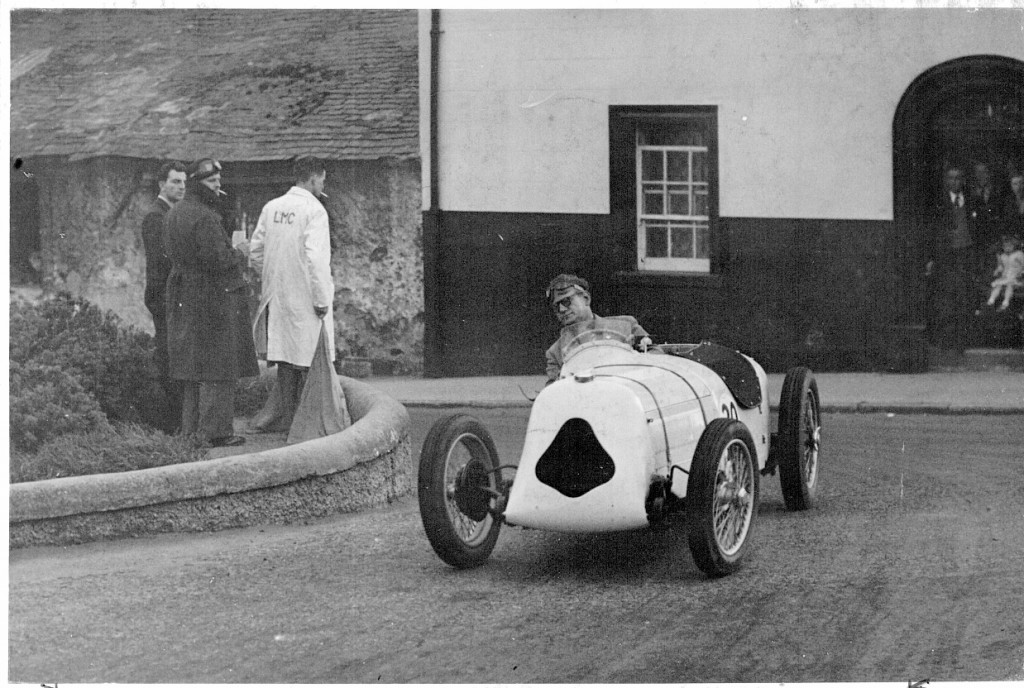 Lester-bodied, but with new nose, in the Leinster Trophy Race at Tallagt.
Lester-bodied, but with new nose, in the Leinster Trophy Race at Tallagt.
Well, these things I did, and I took it down to Brighton. The first day in competition it gained a second place in its class, which wasn’t bad and gave me quite a bit of encouragement.
At this point I thought, “Oh well, if I can get rid of some of the weight, it might help.” Let’s face it; a TC is well endowed in that direction. If I could get rid of some of the weight then no doubt I could be able to increase the performance quite appreciably.
So, in the winter of 1947, I completely stripped the car down to the chassis. I disposed of the body, and replaced by a lightweight Lester body. This got something like 3-4 cwt. The difference in performance was absolutely phenomenal.
Actually, this gave me a lot of encouragement, so right now I had a go at the engine to see if something couldn’t be done about it. As I already said, I knew nothing about engines, but I was very – interested. So I took the engine apart, stripped it right away down to the last nut, and polished just about everything in sight.
I balanced the pistons and the rods myself. I sent the crankshaft and clutch assembly away to Laystalls and had that balanced properly by them. When I got it back I reassembled it. During the meantime I had some special valves made up of K965, slightly larger than standard. I used heavier springs – I forget how much I took off the head, but it was quite a bit.
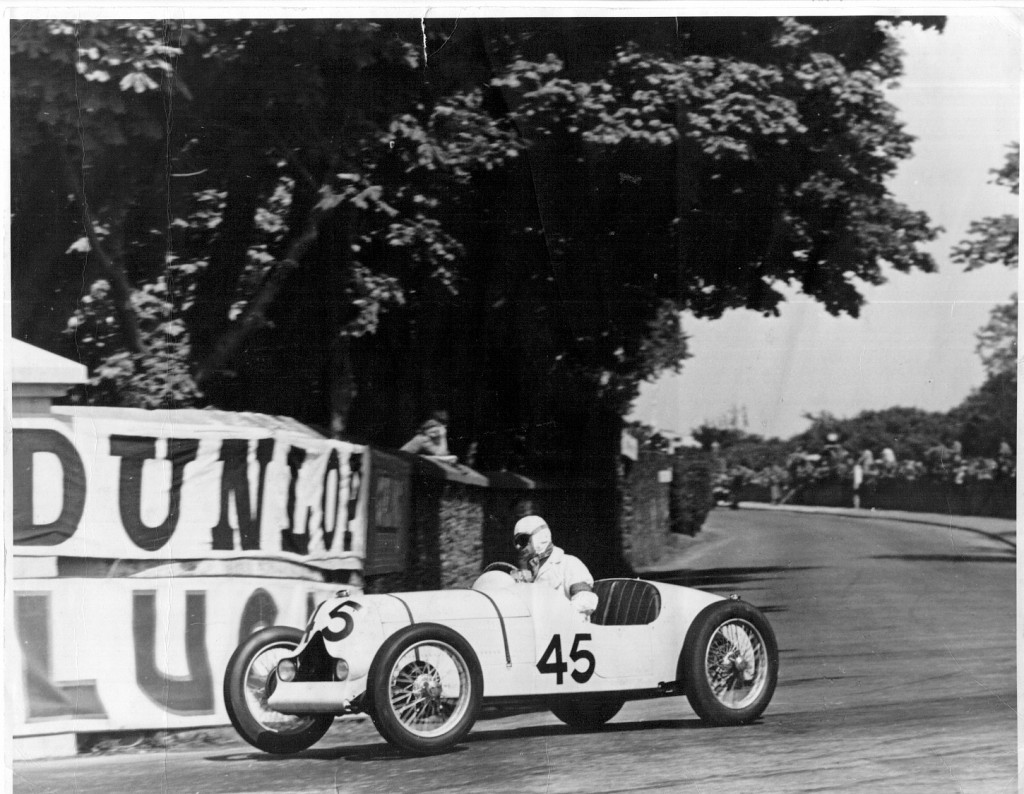 The Lester-bodied TC at Parkfield Corner, in the Manx Cup, Isle of Man.
The Lester-bodied TC at Parkfield Corner, in the Manx Cup, Isle of Man.
Anyway, I assembled this all together and took it out to try. It really was something out of this world. I don’t quite know what horsepower it gave, but it was an appreciable increase on standard.
That I can assure you. Well, by now the new season was approaching, and I naturally wanted to get racing. But unfortunately, when I came to enter races, all I ever got was a rejection slip.
They were oversubscribed, and there was no opening for me. Nobody had ever heard of George Phillips; I was really getting desperate, so I went to the Steering Wheel Club, which was run at that time by Desmond Scannell, who was the Secretary of the British Racing Drivers Club which would put on a race on the Isle of Man, The British Empire Trophy with a curtain raiser, the Manx Cup.
So I asked him why every time I put an entry in, I was rejected. He said, “Well, nobody’s ever heard of you. We have to look after the men we know, and we can’t have any Tom, Dick, or Harry running around not knowing what they can do.” I said, “Well, how am I supposed to start racing if I can’t get an entry?”
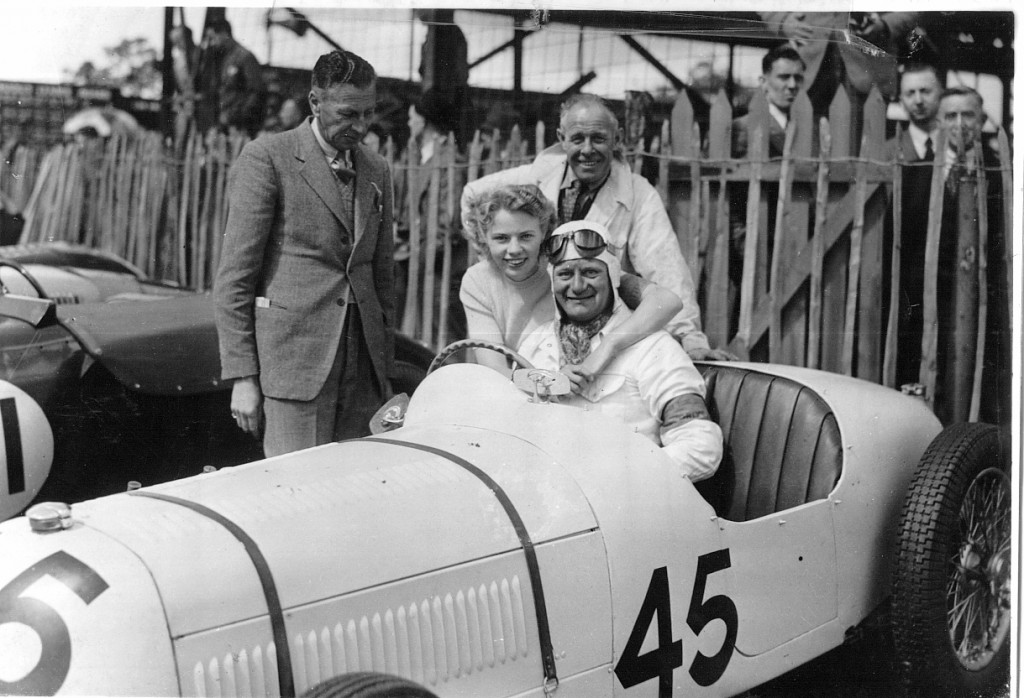 After the first race – the Manx Cup. 1st in class, 4th overall. L to R – Reg Tanner (Esso Competition Manager), “Dunlop” Mac, my wife Barbara and me.
After the first race – the Manx Cup. 1st in class, 4th overall. L to R – Reg Tanner (Esso Competition Manager), “Dunlop” Mac, my wife Barbara and me.
Eventually, however, I came to an arrangement with him whereby I went to the Isle of Man at my own expense just to be observed in practice. If I behaved myself, and they thought that I wasn’t all that dangerous, then they were prepared to let me start. So with that in mind I went off to Liverpool and got on the boat.
During the crossing I got chatting to “Dunlop Mac”, who was a well-known figure in those days. He’d done the record-breaking tyres for all sorts of people such as Seagraves and was a very, very well known man. We had quite a bit of fun.
He was very friendly and he said, “Well, what tyres are you running on, boy?” I said, “I am running on Dunlops.” “Well”, he said, “you can’t run on Dunlop road tyres in the race.” I said, “Well I have Dunlop racing tyres.” He said, “Oh, no you haven’t”. I said, “I bet you I have.” So we went down in the hold and sure enough, I had them. He said, “Oh yes. I remember now. They were the last two we had in stock”, so I won the bet. However, the poor old TC was rather outclassed, as the format of the race was 21/2 litres unblown or 1100ccs blown.
Well, as you know, the TC falls right in between with 1250cc unblown, and that was the sort of competition I was faced with. The race turned out quite well for me, as I was the first small car to finish. I was, in fact, placed 4th overall headed up by three 21/2 litre cars, so the result from my point of view was very satisfactory.
That 4th place helped me no end because, as a result of it, I never had any further bother with obtaining entries in other races. I became a member of the British Racing Drivers Club during the summer of that year and competed in various sprints with quite a lot of success.
In August of that year, I got an invitation from the Ulster Club to take part in the Ulster Trophy Race at the circuit just on the outskirts of Dublin. This is one of those peculiar Irish affairs which is run on handicaps so one really never knows where one is however, once again the TC acquitted itself quite well although during the race it started to handle like a pig.
I couldn’t quite understand what was wrong with it but when we finally finished the race I was fourth. I was just nicked for third place by Reg Parnell in a full-race Maserati; I really couldn’t grumble. The handling problem turned out to be because I had fitted some Hartford Friction shock absorbers on the front.
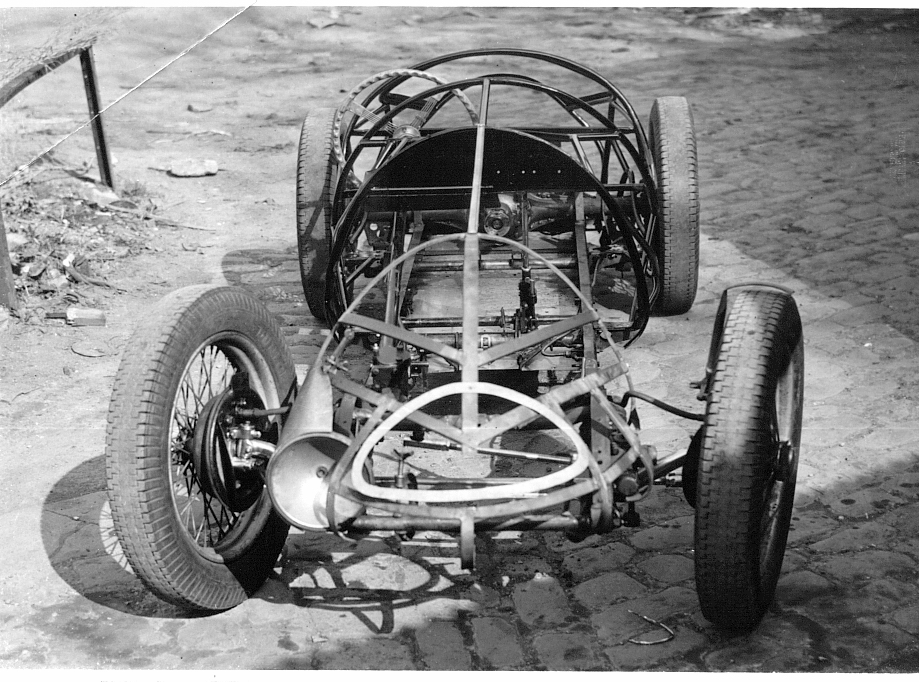 The frame work and finished body, made by Tim Goodwin.
The frame work and finished body, made by Tim Goodwin.
I’d obviously got them adjusted a bit too tight, and they had torn a lump out of the channel of the chassis so the near side front wheel was flapping about in the breeze.
The next event of any importance was the 12-hour race at Monthlery in Paris. I must say, if anybody asks me what my favourite circuit was, it would undoubtedly be Monthlery. It has absolutely everything on the road section: all manner of corners, adverse cambers, rises, drops, everything you can think of, then you finally finish up doing half a lap of the speed circuit which is banked very steeply, and that takes you out to the road section again.
My co-driver on that occasion was Oscar Moore, who used to drive a BMW 328 and HWMs, and things like that. He liked the handling of the TC, and he was very quick with it. The club supplied the fuel for this race, it was a substance called Tenaire 3, which was a potato alcohol, and I mention it because it suited the TC admirably.
There was one snag, every time we came in for a pit stop, the darn thing refused to fire up again. Eventually after a couple of times I got fed up with this so I lost my temper and threw a bucket of water over it just to cool it down. Presto! We had no more bother, but it just goes to show that my ignorance of things mechanical was such that to throw a bucket of cold water over a red hot engine is not exactly the recommended procedure. In this case I got away with it.
It worked so I can’t really grumble. I must say, the car ran beautifully. It never missed a beat and except for the hiccup at the start with those first two pit stops, we had no trouble whatsoever during the whole 12 hours. We finally finished a creditable 4th in class, which I don’t think was too bad.
And so back to the Brighton Speed Trials, where it was just one year before when it all started. I was a little more successful on this occasion, though, and managed to win the class. The final event in the 1947 season was the opening of the Goodwood track. I entered the 1500cc class race and managed to win it by a very narrow margin from Gerry Ruddock’s HRG, and so concluded a very enjoyable season which had provided me with a few good results.
Sometime during the winter of 1948-9, the ACO, which is the Automobile Club de l’Ouest, reorganised Le Mans and announced that they were going to run the 24-hour race in June of 1949. This really excited me, as it had always been an ambition of mine to compete there. I contacted the famous Bentley Boy, Sammy Davis, who had competed there several times, and was also one of the drivers of the winning car in 1927, to ask him what he thought my chances of getting an entry in an M.G. with a special body.
His reply was most encouraging. He said there was no earthly reason he could think of, provided the body dimensions complied with all the regulations. So I immediately sent off for the regulations and an entry form. When I received them, I must say the regs did look to me very daunting, having been used to the English type of entry regulation, which was usually a two-fold affair.
This formidable volume was some 50 pages of closely printed French. I concentrated on the section that dealt with the dimensions of the bodywork and decided to re-body the TC. I had been thinking about it for some time so this really gave me the excuse I needed to get on with the job.
The question was, where could I get somebody to do the work? I knew what I wanted, but I had no way of possibly illustrating what I had in mind. However, a friend of mine knew a panel beater who ran a one-man business from a small workshop in a north London suburb, so he took me along to meet him.
Ted Goodwin was his name. I explained roughly to him what it was I had in mind, and asked him if, in spite of having no drawings or anything to work from, whether or not he would be able to help. He said if I could explain to him what it was I wanted, he could make it up as we went along. Work started in the early part of 1949, and Ted turned out to be an absolute wizard.
We worked together very closely, and finally, by using the well-tried method of trial and error, the framework was finished. Then it was all down to Ted to clothe this skeleton in 20-gauge alloy. When he finished the job, I was more than pleased with it. By now, I could think of nothing but Le Mans, it was an absolute obsession with me.
When we left you last month, George was just getting ready for his attack on the 1949 Le Mans 24-hour event. In this episode, we find out how George got on in that event, and how it influenced his attempt the following year. The third, and final part of his story appears next month. For those of you who are interested, I would just add that none of the photographs used have ever previously been published in this country.
In the previous section, George was getting ready for his attack on the 1949 Le Mans 24-hour event. Below we find out how George got on, and how it influenced his attempt the following year.
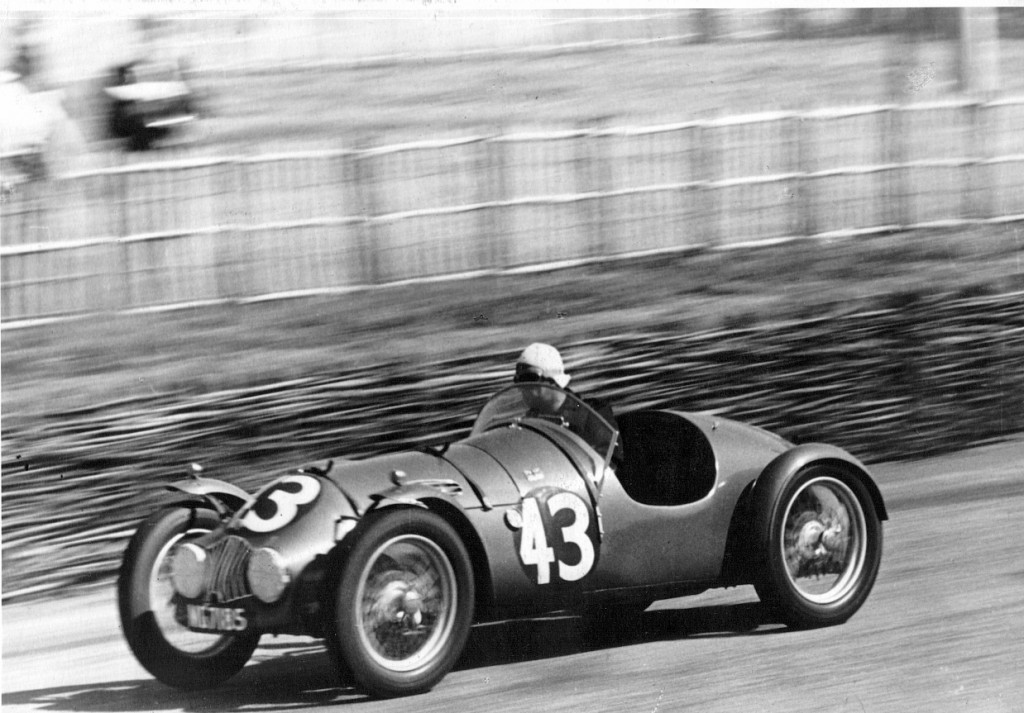 George Phillips testing the track near Arnage.
George Phillips testing the track near Arnage.
The first thing I had to fix up was a co-driver. I was, at that time, very friendly with Curly Dryden, who raced a Q-Type M.G. He was ‘mine host’ at the George Hotel in Dorchester, a village quite close to Abindgon, the home of M.G.s. I put the suggestion to him, would he like to come to Le Mans, providing I got an entry?
He was very keen and agreed on the spot. I said there was one snag – I can’t make a lot of sense out of the regulations. Did he know anybody who could help in that direction? To my amazement, he said he knew just the very chap. It was a customer of his who turned out to be a Frenchman but, believe it or not, taught English at one of the colleges at Oxford.
So in no time at all, we now had, in our possession, the full text in English. In the meantime, I had stripped the engine down and checked everything very thoroughly, I was agreeably surprised at its condition, but as a precaution I renewed all the bearings, piston rings and valve springs. After a hard season, plus the fact I used the car everyday on the road, the engine condition was pretty remarkable.
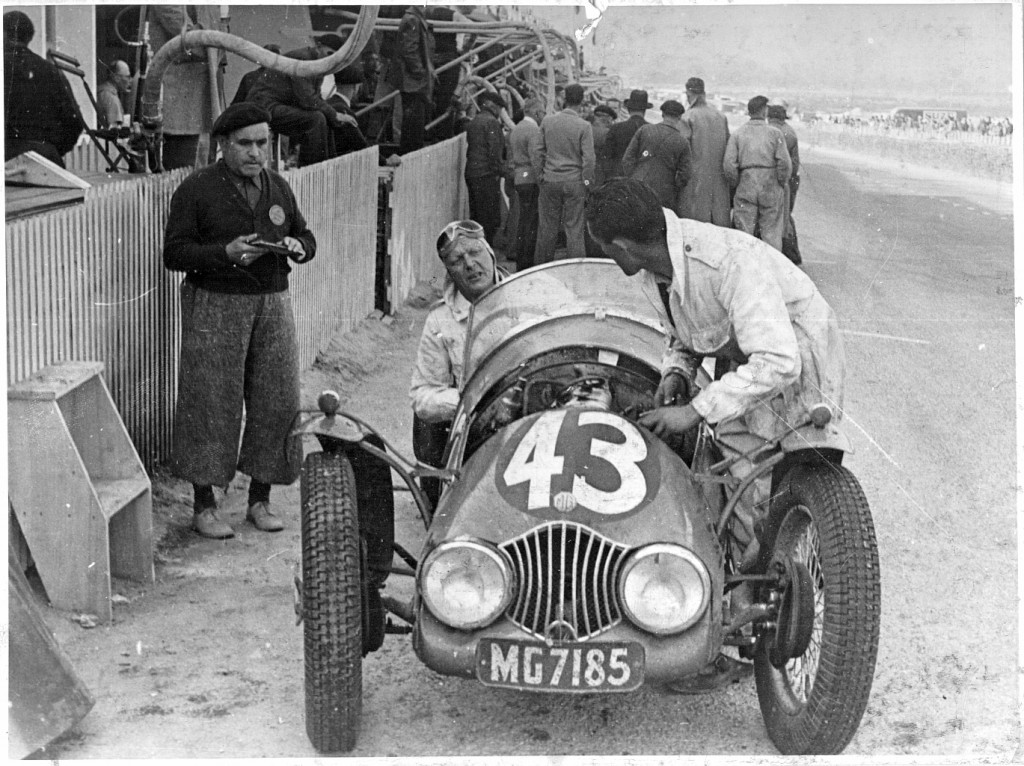 Willie Wicken changing the condenser for the first time. The new one failed and this eventually led to the elimination of the car. Curley Dryden (in the car) looks on anxiously, whilst everything is carefully watched by the French Commisar in the pits.
Willie Wicken changing the condenser for the first time. The new one failed and this eventually led to the elimination of the car. Curley Dryden (in the car) looks on anxiously, whilst everything is carefully watched by the French Commisar in the pits.
By now I was getting the co-operation of the factory, in as far as the availability of spares were concerned; in fact, they even gave me a discount. Meantime, I met and became quite friendly with John Thornley, the Managing Director of M.G., who was very interested but a little sceptical about what I was doing. Getting to know John turned out a very good thing for me later, as it led to my works drives. Then one morning, ‘it arrived.
The letter I had been waiting weeks for. I had been accepted for Le Mans. I was over the moon at the news. But as a result of it, I’m afraid my racing suffered in the early part of 1949, as from then on, it was just a question of organising everything. Curly Dryden provided the mechanic, and the tender car.
I was responsible for the racecar and all the spares, tires etc. We stayed at the Hotel Moderne, which was the place where the Bentley team used to stay in their heyday; in fact, their sign still hangs on the wall out in the courtyard. We were in good company there, as the Aston Martin team, and the Ferrari team, were also staying there.
We arrived there on Monday, due for scrutineering the following day. This turned out to be quite an experience. The car was wheeled into an enormous garage. Around the perimeter were about a dozen or so trestle tables, each one of which checked an item on the car. These proceedings took about 21 hours to complete.
Finally the car was wheeled outside over a tray of sand and the engine started and revved up to see that the exhaust didn’t disturb too much sand, which would create a nuisance when it was on the track. I was very pleased to be able to report that the car got itself through its scrutineering with no snags whatsoever, and we had no work to do on the car.
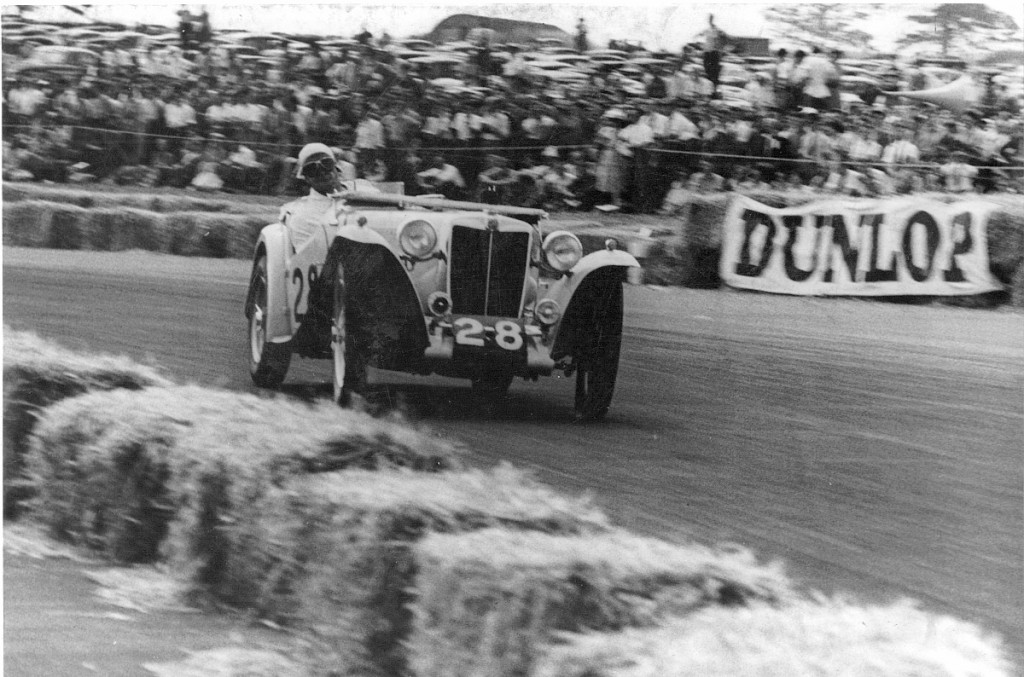 George, driving one of the ‘works’ John Thornley TCs, seen here skirting Copse Corner at Silverstone in the 1949 One-Hour Production Car Race.
George, driving one of the ‘works’ John Thornley TCs, seen here skirting Copse Corner at Silverstone in the 1949 One-Hour Production Car Race.
Then we all adjourned to the Hippodrome, which is situated on the straight at Le Mans, for a few drinks. It wasn’t long, however, before Curly and I were taking it in turns to do a few unofficial practice laps. We were both very impressed with the circuit. It was superb.
It must be understood, however, that we had to be a bit careful as the roads were open for every-day traffic, but at least we got some idea as to how the car was going to perform. At that stage, I felt quite happy with everything. The following day saw the start of the official practice, which we spent learning the circuit.
The car ran well. Times, although not important at this point, compared favourably with other cars in that class, with the exception of the Gordini prepared Simcas: these were very quick. As it turned out, in the race they were no opposition, for they were very fragile and were soon out of the actual event.
The following day our entire party went for a stroll around the town and did some shopping, finally finishing up at the famous “Grubers”, a large cafe on the main square of the town. The practice that evening we treated a little more seriously carefully checking petrol and oil consumption. Oil consumption was negligible, and petrol was somewhere around 22 miles to the gallon.
So I was thankful that I had opted for a 16-gallon tank, which had of course, been made from alloy by Ted Goodwin. This meant that we could do 4-hour stints. This would enable us to do more than the 25 laps stipulated in the regulations, and leave us with a comfortable safety margin. Tyre wear was non-existent, so I could see us completing the race on one set of tyres, provided, of course, we didn’t get any punctures.
When darkness fell, my final problem was about to be put to the test – LIGHTS. I had opted for just two high-powered but rather narrow-beamed Lucas lamps, affectionately known as ‘flame throwers’. This was rather a gamble on my part, as they were a new lamp and had not been used as headlights before, but they turned out to be very satisfactory as a large spread of light wasn’t really necessary.
All things considered, everybody seemed quite satisfied with the situation. On race day, we had to be in the pit by ten o’clock in the morning, and the scenes in the pit area were something that one has to see to really believe. There are literally thousands of people milling around all over the road and in the pit area, talking to the drivers and the crews, or looking at the cars.
At about 3:30, the gendarmes swing into action. A line of police, shoulder to shoulder across the width of the track, work their way right along the pit area, sweeping all before them, and before you know where you are, the road is absolutely clear. The cars are then lined up in echelon formation on the pit side of the circuit, and at 3:59 the drivers are standing in their circles opposite.
At four o’clock, Charles Faroux, the starter and the man who thought the race up in the first place, drops the Tricolor. Then comes a patter of feet, the whirring of the starters, then all hell breaks loose, as race cars get away into one gigantic high speed traffic jam. This takes itself a few laps to sort out before finally settling down to something like normality and getting on to your own time and plan.
There are some that look upon the race in the early stages (that’s the bigger boys of course) as a Grand Prix, and they are still doing it to this day. They go off like mad as if the race is just a short event, instead of a 24-hour one. This, of course, rubs off on some of the smaller boys and they start going off mad as well.
Before they know it, they are out of the race, stuck on the side of the road. There is really only one way to go about this race, and that is to have a pre-determined plan. One should bear in mind the car’s capabilities and stick to the plan firmly.
After all, 24 hours is really a long time, Our plan was working very well; the car ran perfectly all through Saturday and into the night with no trouble whatsoever. I did the dawn stint, and found the local fog a bit of a problem as it shifted about from lap to lap. It doesn’t last all that long. I pitted and handed over to Curly somewhere about 9 o’clock.
I went and had a wash and a shave and a general freshen up, and went around visiting some of my fellow competitors in their pits. Then I went back to my pit where my wife was still running things. She hadn’t had much rest in all of the time. I hadn’t been there long when Curly went past, and I thought I heard a slight misfire.
So we waited anxiously for him to come round again and, sure enough, there was an intermittent misfire. I talked this over with the mechanic, and we decided it sounded as if the condenser was packing up, so we told my wife to bring Curly in the next time round. When he arrived at the pit, he said that the misfire came in around the 5000. The condenser was changed, and he went out.
Next time round, the car was running very sweet. As he went past, he gave us the thumbs up signal.
Several laps later, the same fault started again. This time with far greater effect. Curly had gone missing, no pun intended. So after nearly 20 hours of trouble-free running, we were now sidelined. Once again the mechanic and I thought it was ignition trouble. I had, in the pit, a Scintilla Vertex Magneto. The trouble was, it had to be in the car if I was to use it, as all the spares that were liable to be needed during the race, had to be carried on the car.
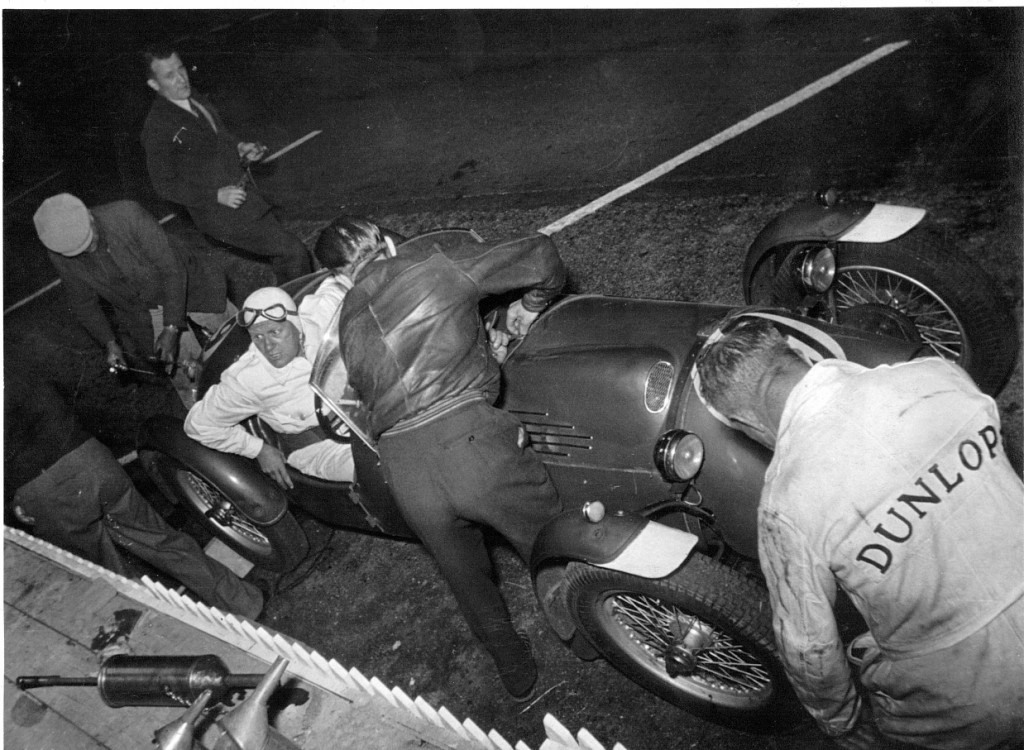 George climbs into the car during a routine night stop. The few mechanic’s tools are ready to hand in the pits.
George climbs into the car during a routine night stop. The few mechanic’s tools are ready to hand in the pits.
But in sheer desperation, I sent Willie out with the magneto, with the instructions to try to find Curly and somehow substitute the distribution for the mag.”But”, I said, “If you do find him, do not touch the car because the regs say that only the driver can work on the car out on the track.”Just shout to him and tell him what to do.” He did find him, and, this wants a lot of believing: not only did he touch the car; Curly brought him back in the passenger seat!!
The result was an immediate disqualification. I can tell you, I was livid. Having fitted the Scintilla, I had no more trouble. I drove the car back to England and used it everyday from then on. i did a few small events, picking up the odd award on the way.
The next exciting thing that happened to me was John Thornley decided to enter a team of three TCs in the sports car race at the British Grand Prix meeting. They were to be driven by Dick Jacobs, who had been enjoying considerable success in his 1100 blown M.G. special, Ted Lund who also was an M.G. enthusiast, and myself.
They were actually going to be standard, even down to carrying side screens. Although not terribly fast, all cars finished at an average of close on 70 mph, a result that delighted John Thornley. That was really all that mattered.
At least some interest was being shown in high places. My next surprise, nay shock, was receiving a letter one morning from the ACF, which is the Automobile Club de France, and inviting me to take part in the French Grand Prix, which they were running that year as a sports car race in Comminges. I naturally enough accepted.
When the time came, l set off just with my wife and a friend I had known years before the war, during the speedway days. He was to drive my Morris 14 in convoy with me, and act as mechanic. We duly arrived in Paris, and I reported to the ACF on the Place de la Concorde. I asked which way was the best way to the circuit.
Imagine how I felt when they produced a map of France and proceeded to instruct me on the route to Comminges – I was dumbfounded. In my excitement at being invited to take part in the race, I hadn’t bothered to check where Comminges was. I thought it was near Paris, like Montlhery.
Instead of that, I was now faced with a journey of some 600 miles to the French coast. On the way down we passed Montlhery, and I asked my wife if she would like to see the circuit. So we spent a very enjoyable hour blinding around the road circuit (something I was to regret later on).
We stayed that night at Limoges, where they had a water problem, and each room only had one vase full of water. As we had done several hundred miles in the TC we were absolutely black, so you can imagine what the water was like.
You could almost cut it out of the basin and throw it out the window. Eventually we arrived at St. Gaudens, the nearest town to the circuit. I must say this was about the hottest place I had even been. As I recall, the temperature was around 100 degrees.
I had no trouble with scrutineering, and we went out to practice. For some reason the car was using quite a bit of oil, but the real trouble was my so-called mechanic didn’t know how much he had added. So I started the race a very worried man. Anyway, the car behaved perfectly, and at about half distance I was leading the small class.
Then disaster struck. The bend after the pits was a fast downhill right-hander. As a result of the oil surge on that corner, and the fact that the oil was low, all the bearings went in a second. This, as well can be imagined, was a bitter disappointment, but it also presented me with a major problem of how to get two cars back to England.
No way could I face being towed some 700 or 800 miles across France. So I hired a flatbed railway truck, and put the two cars on that to Paris, and then towed the M.G. with the Morris tender car, back to London. I have often wondered if I would have finished that race if I had not taken my wife for that blind around Montlhery.
At home, I stripped the engine down and replaced all the bearings. Fortunately the crankshaft was undamaged. I also replaced the rings and valve springs. I competed in a few smaller events and so brought the 1949 season to a close. During the Winter of 1949-50, I built myself another engine. My original one was OK, but I thought it was about time I gave it a thorough overhaul.
This included reboring the cylinders, then sleeving them back to standard. I did this by fitting “Cromard” liners, which had a reputation for being very hard wearing, as indeed they were. I remember one little scare I had when I had completed this engine; I ran it in the usual way for some thousand miles, and then went testing for performance.
To my dismay, I was about a 1000 revs down. I tried everything I knew to improve the performance, but whatever I did didn’t seem to get any response. So I contacted Basil de Mattos who was a technician at Laystalls who had fitted the liners, and done the rebore. I explained my problem and he told me to stop worrying, as Cromard liners were so tough, it took about 10,000 miles before it could be said that they were really run in. This proved to be absolutely right.
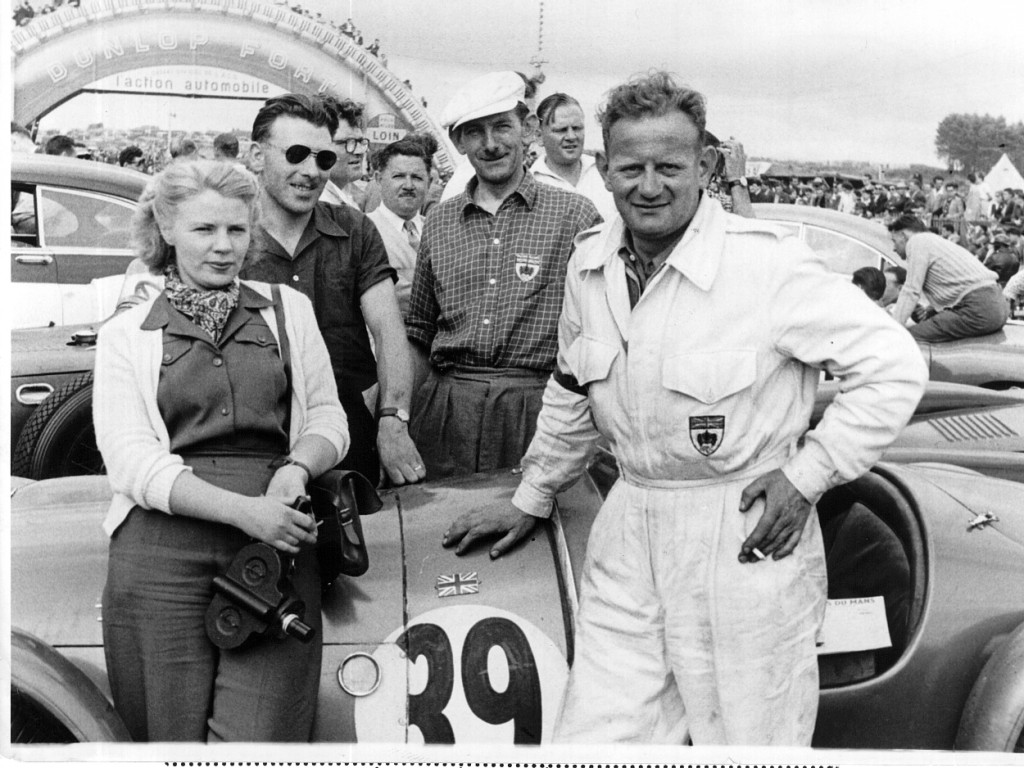 The successful 1950 Le Mans team. L to R are Barbara Phillips, Denis Jones (mechanic), Eric Winterbottom, and George Phillips.
The successful 1950 Le Mans team. L to R are Barbara Phillips, Denis Jones (mechanic), Eric Winterbottom, and George Phillips.
When I finally did about that distance, the engine did perform well. So, I decided at that point, that it would be the engine I would use at Le Mans in 1950, because I had succeeded in getting an entry for the race. I opened the season with a few small races at places like Goodwood and Silverstone, but, of course, my main aim was Le Mans again.
This year I had, as my co-driver, yet another inn-keeper, Eric Winterbottom. He was a charming chap and was quite impressed with the car. When he asked me what the rev. limit was I replied, “Please yourself – the engine is unbustable.” He looked at me as if I were mad, but I really had that much confidence in it! I took the car back to Le Mans exactly as it was the previous year.
As I actually had no aggravation in 1949 at scrutineering, I expected to get through without any bother. But no. This year, they made me fabricate extensions for the front mud-guards, and rearrange my fighting system which meant fitting another set of lamps (see photo below). They even made me fit a wider bonnet strap. We completed this work and were passed OK.
George climbs into the car during a routine night stop. The few mechanic’s tools are ready to hand in the pits. Practice went off without any problems, and both Eric and myself felt very happy about the way the car was running. We had set ourselves a pattern as to the manner we would run the race.
Our only object was to finish and qualify for the Bi-Annual Cup. And so with this aim in mind, we stuck to the plan religiously. As with all things, when they go OK, there really is not a lot to report. Suffice to say the car ran perfectly throughout, but the closing laps were really something exciting.
All the way round the course people were waving at you with their hats and programs. It really was a wonderful experience that I shall never forget. When all the excitement of being in the finish and things had died down, I worked out rapidly what the car had achieved.
We had covered 1760 miles at an average speed of 73 mph. We had used no water, 1 pint of oil, got around 24 miles to the gallon, and we were still on the original tyres. We had finished second in the class to a special works Racing Jowett Jupiter. Altogether it was a very satisfying result.
This final chapter looks at his efforts in the 1951 event, Works-team racing, and the development of the MGA. George also takes a look at his gradual retirement from competition motorsport, and how he became involved with the Autosport magazine, where he finished up as Chief Photographer.
I continued to do smaller races, sprints and hill climbs with some success, but the next really exciting event was the appearance of the TDs for the one-hour production sports car race at the British Grand Prix meeting at Silverstone. It must be said that the performance of the TDs was disappointing.
They were only fractionally faster than the TCs the previous year. As they were MKlls, one of the features of the special occasion were large sodium cooled exhaust valves, and this was a decided improvement. On the day of the race, I got away to a good start and was running among the leaders of the 1500 class.
Well, I over did it at Woodcote and finished up on the infield losing my advantage. I managed to get back on and the TDs finished second, third, and fourth behind Gerry Ruddock’s 1500 HRG. At this point, not being used to IFS, I did not find the handling to my liking, which no doubt had something to do with my spin off.
M.G. were obviously satisfied with the result, and they announced soon after that we were going to the TT. This race was being run over a circuit in Northern Ireland at Dundrod, which is a town just outside of Belfast. It was a works fully supported effort. There were three cars, which we had used at Silverstone. Together with a practice car, four mechanics (including Henry Stone) headed by Alex Hounslow and Reg Jackson. John Thornley and his wife also came. So the works was well represented.
The local Nuffield dealer had loaned us a car, so the three drivers spent a lot of time going around the circuit, which was a very difficult one to learn. Not unlike a miniature Nurburgring, many of the bends having blind approaches so it paid to remember if the road went right or left. The race itself I will never forget.
It was without a doubt, the most miserable event I’ve ever taken part in. There was a howling gale and rain, and it had to be seen to be believed. No way would the race start nowadays under those conditions. And there we were, faced with three hours of it. I had never been so uncomfortable in my whole life.
I bought a set of waterproofs that morning, but in spite of them, I was soaked to the-skin within ten minutes of the start. Anyway, in spite of all this, we were 1, 2, 3, in the 1500 class. So that went a long way in restoring our spirits. It was after this event that the factory offered the 3 drivers the chance to buy their cars, which we all availed ourselves of.
By now I was a full time member of Autosport, a new motoring journal that had appeared in August 1950 and was edited by another M.G. enthusiast, Gregor Grant. I was to be the chief photographer. He had a Y Type M.G. at the time, and he had entered it in the MCC Daily Express Rally. Although I don’t remember much about it, this was the first time I had done a rally, and the thing that stands out in my mind was the loss of sleep in these events.
The result was satisfactory, as we were members of the winning team. By now it was a closed season, but the factory made a nice gesture to the drivers at the Annual Dinner and Dance of the M.G. Car Club, They presented each of us with a pair of gold octagon-shaped cufflinks inscribed “in appreciation, Nuffield.”
A nice surprise, which all three of us were delighted with. During the winter of 1950-51, I went to the factory to see John Thornley to try to sort out what we were going to do about the 1951 Le Mans entry. Having finished in 1950, I was automatically accepted for the 1951 race, driving any car I wished. I still wanted it to be an M.G.
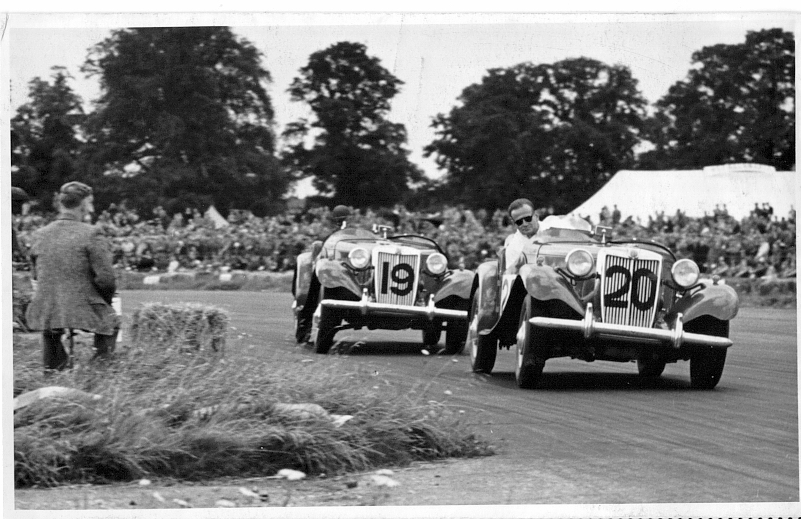
George Phillips (20) and Dick Jacobs (19) at Copse Corner in the works TDs, during the One-Hour Production Race at Silverstone in 1950.
The trouble was, there was only the TD, so we had long discussions; John Thornley. Syd Enever, and myself, as to what could be done. It was decided that the works would build, albeit unofficially, a special-bodied lightweight version of the TO. Work was started in the winter of 1951 in the development department.
As the project grew, more care had to be taken to keep it out of sight of a Director by the name of Smith, who used to come down every Tuesday. The day finally came when the car was completed, and the man had to see it. There was ‘ some apprehension in the works as to how he would react, fortunately he liked it, so everybody from John Thornley down breathed a sigh of relief.
Although the company had been good enough to build the car and gave me £150 towards my expenses, their help finished there. They never sent a mechanic or anyone from the works, and I was entirely on my own.
That year, I had for my co-driver, Allen Rippon. He used to race a 500 cc Cooper Norton. He was the ideal co-driver – a very pleasant and affable character, who listened to what you said and never lost his cool. He paid the same as my previous partners, which was £100 toward the many expenses incurred in a venture of this nature.
When I went to collect the car from the factory, I felt very proud, and very pleased with the look of the car. The body was, for that time, a very pretty and workmanlike looking job, with its long low flying lines that looked really efficient. At scrutineering, the car created a lot of interest.
There had never been a road going M.G. that looked anything like it before. Although in some aspects, one could detect its ancestry in the Gardner record-breaking car that Syd Enever had designed. The only snag was that the driver sat on it instead of in it. This was dictated by the chassis of the TD. Scrutineering presented no problems as all the regulations had been taken into account during the building of the body.
So to the practice, where it was driven for the first time in anger. It went quite well, although I didn’t like the handling of it as much as my TC. I still wasn’t happy with the I.F.S.
Another thing that worried me was the pinking I was getting all too often from the engine. We took the car back to the garage, and after checking the timing and the mixture, and so on and so forth, it seemed OK, I spoke to John Wyer, the Aston Martin Team Manager, who was having the same problem. In his opinion, it was the fuel that was at fault. He was livid and threatened to withdraw his the race unless something was done about it.
In view of what he said, I decided to take the head off and fit two gaskets. I was going to try it out that night in practice. It was an improvement as it didn’t pink any where near as much, so I decided to run it in this form for the race.
Naturally the times were better than the TC, as the streamlining gave maximum speed. I seem to remember reading somewhere that it was timed at around 120 mph on the Mulsanne Straight, which wasn’t bad for a 1250 cc engine.
I started the race and had a first-hand view of the big boys out there in their usual 2 hour Grand Prix. They were passing me at speeds often half as much again as mine. Soon the race settled down to something approaching normality, and my times had gradually been coming down nicely, when I got the sign that I had done a 6-minute lap.
This really was exciting news. Whether I got carried away, or the engine had suffered damage due to the bad fuel, I will never know, but I was just about to overtake May’s Bentley when there was a clatter and the engine went on three cylinders, so I limped around to the pits.
As I had done more than 25 laps, I was able to remove the valve cover and discovered the worst, I had dropped a valve and it had punched its way clean through the piston. We refueled, and I said to Alan to take it out and see what it can do on three cylinders. “At least you will have had a ride.”
Obviously we couldn’t last long under those conditions. Eventually the unburned petrol diluted the oil to such an extent that the big-end bearings finally went, and my 1951 Le Mans race was finished.
There was a not-too pleasant meeting at the works when I finally got back to England. I had gone straight to Reims to photograph the French Grand Prix. A friend had brought the TD back for me, and there were recriminations on both sides. I said, “If I could build an engine in my kitchen that would last for 24 hours and used daily doing other events without any trouble, I would have thought that you could have done the same.”
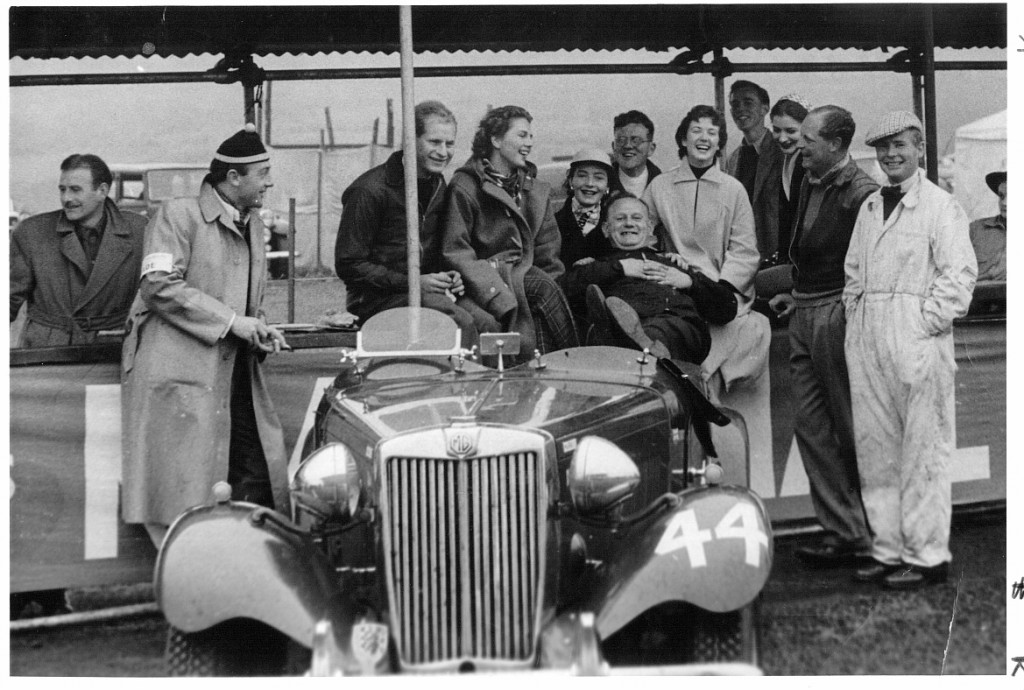 The final race in 1953 was the TT at Dundrod. The team is seen here, passing the time away during the wait for the delayed start. Raymond Flower is second from the right, standing next to Ernie McMillan in overalls. Standard ‘racing’ attitude is applied to the headlamps.
The final race in 1953 was the TT at Dundrod. The team is seen here, passing the time away during the wait for the delayed start. Raymond Flower is second from the right, standing next to Ernie McMillan in overalls. Standard ‘racing’ attitude is applied to the headlamps.
They, in turn, blamed me for being lead-footed, so nothing really came of that. When all the dust of that settled, they asked me how I felt about the car. I agreed the shape was good, but it was a pity the driver had to sit on it, instead of in it. If this problem could be solved, I thought, perhaps, it had the makings of a good car and so, from that exercise, I like to think the MGA was born. It was more or less at this point that my competition activities finished.
I was now kept very busy with my photographic work on Autosport, what with trials, motor shows and events like the Monte Carlo Rally during the Winter, followed in the Summer by a full Grand Prix program, plus race meetings every weekend. I found less and less time to actually compete.
I did one or two events in the TD but with no success, in fact, the only thing I remember about the car was the regularity with which it used to break its crankshaft. It always went in the same place, across the front web immediately behind the front main. Why this used to happen I shall never know, nor did anybody I spoke to have any suggestions.
The final curtain for me was once again the TD in Dundrod. My Editor got me a co-drive with Raymond Flower. He was unknown to me but had a distributorship of some kind in Cairo, and as far as I know, had never raced before.
Although he had done rallying, such as the Alpine. Came the day of the race and as usual (at Dundrod) the weather was foul.
It wasn’t rain this time though, but a very heavy mist, which caused an hour delay. It was to be a 9-hour race. Raymond Flower started the race at 10 o’clock, Unfortunately his lack of experience was soon apparent, for he was losing ground rapidly, to similar cars. I tried to get him to get the car a bit quicker but to no avail.
Eventually he came in for a driver change, and I was faced with trying to make up some of the deficiency. I was successful to some extent. Some of our direct competitors had fallen by the wayside, and we were beginning to get somewhere.
Then he took over again, and so it went on through the race. When I took over for the last stint, Raymond said to me, “I want you to come in just before the end of the race so that I can finish”. So I just said OK, and left it at that, but I had no intention of so doing because we were now in the situation where it looked as if we might do some good in the production car event.
I went out knowing the situation was going to be very marginal. So, I thought to myself, I would sort of play it by ear and watch for the petrol warning light to come on. In the meantime, an Irish friend of mine who had been a competitor but was now out of the race, took over the pit.
With more experience than Raymond, he was able to keep me informed to the situation between myself and the 1500cc Singer of Peter Reece and Gill Tyrer. It was now getting very tight between the two cars, and it was really only a matter of seconds, but by this time even I was getting worried about the petrol situation.
I kept a weather eye on the warning light. It hadn’t come on, so I pressed on, and in the end I thought there was something very strange here, because it should have been on by now. It was a case-of -all or nothing, so I pressed, on until I finally got that welcome of the checkered flag. We had won the production car race by just a few seconds.
As soon as I passed the flag, I went straight into the paddock, because I thought I couldn’t possibly get there on another lap. We had to supply a sample of the petrol we were running on, according to the regulations, and when the scrutineers came to get that sample from the tank, it was just impossible to extract anything from it.
It was completely empty. So they drained the float chambers of the carburettors and took that away. When I checked why the warning light hadn’t come on, lo and behold, the bulb itself had gone. So I was really very, very lucky to get away with that. Naturally, Raymond Flower was a little bit annoyed with me, and kept on saying “You might have blown it.
You might have run out of petrol on the course, and we would of got nowhere”. I said, “Yes, I realise that Raymond, I’m very sorry. But we didn’t blow it -we won the production car award, so you should be very satisfied.” He eventually saw it my way, and of course, at the prize giving, he went up to collect the trophy. He was very pleased, and there was plenty of celebrating going on that night, I can assure you.
That was the last time I drove an M.G. in anger. The final occasion of me just sitting in an M.G. was when the present owner of my old TD, invited me to drive it in the parade around Brands Hatch, during the Golden Jubilee Celebrations of the M.G. Company. G.P.

 MG Car Club
MG Car Club